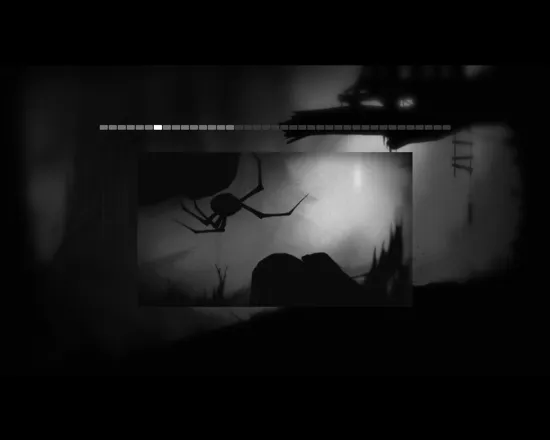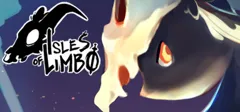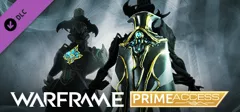Limbo
Description official descriptions
Limbo is a side-scrolling puzzle platformer set in a sinister, monochromatic world. The player controls a protagonist simply known as The Boy, who is said to enter the world Limbo in search of his sister. However, the story as a whole can also be seen as a metaphor for the search for companionship and getting around in a new environment. Not a single clue is given at the start, there are no cut-scenes and the game starts right away. In that world filled with hazards and danger, his means are few and he is extremely vulnerable. Only two buttons are used, a feeble jump and one to perform an action, combined with movement. This allows him to explore the world and hang on ledges, slide down slopes, push objects, pull levers, and cling to ropes, but the player has to make most of what is present in the environment to get by, often with physics-based elements.
The gloomy world has a dusty filter showing the game through misted glass, and no vivid colours are present. It is divided into 24 chapters that seamlessly flow into each other, only from the level selection in the main menu can be derived where a new chapter starts. The world is rendered in 2D but with different layers of depth in the scenery. It moves from a forest to an abandoned city and eventually an industrial zone. The player faces three kinds of challenges. There are obstacles where The Boy simply needs to find a way to progress, there are dangerous creatures that hunt him down and try to kill them, and finally there is a gang of children who band together to ward off the intruder and set up traps for him, with a touch of Lord of the Flies. Encounters with other humans are however brief and rare. These account for most of the horror moments, of the psychological kind, with other unnerving sequences like when the player is forced to use the corpses of other children as a bridge.
Music and sound effects are minimal and there are no on-screen elements referring to health or other statistics. Every single misstep, often with gruesome consequences, is fatal. In the same vein the boy cannot jump from great heights or jump very far. When dead, the game immediately reloads before the current puzzle. Most of the encounters are centered around puzzles and these are sometimes based on timing or speed when being chased. Other elements serve only for setting the scene, when The Boy gets to ride a boat to cross a lake (he cannot swim and drowns immediately) or finds the corpses of the people who did not make it in Limbo. Most of the game elements are discovered through experimentation, like the effects of a glowing worm that attaches itself to The Boy's head, changing the flow of gravity, or what happens when a giant spider captures him. There is only a single path through the levels and generally there is only a single solution to a problem.
Groups +
Screenshots
Promos
Videos
Add Trailer or Gameplay Video +1 point
See any errors or missing info for this game?
You can submit a correction, contribute trivia, add to a game group, add a related site or alternate title.
Credits (Xbox 360 version)
168 People (140 developers, 28 thanks) · View all
| Created and Directed by | |
| Director of Development | |
| Producer | |
| Art | |
| Sound Designer | |
| Composer | |
| Boy Programming | |
| Boy Animation | |
| Lead Game Designer | |
| Lead Level Designer | |
| Design | |
| Scripting | |
| Programmers | |
| [ full credits ] | |
Reviews
Critics
Average score: 89% (based on 88 ratings)
Players
Average score: 3.7 out of 5 (based on 167 ratings with 4 reviews)
The Good
- Excellent visuals and sounds.
-
Gruesome, violent death scenes.
-
The Boy is a lot like me. Wears glasses (or not; can't really tell). Not the athletic type but he is a survivor (he respawns right after each death).
-
Some of the deepest exploration of interpersonal relationships in video gaming. You feel these characters. The vicious guys (bullies) who try to kill the Boy. It's a cold world, not because of the natural hazards, but because of people. Bad, evil, people. The human race is constantly turning against each other and fighting each other. We will be our own demise.
-
The Boy is an unnamed protagonist.
-
Well, I'll keep talking about the Boy. He is the main reason why Limbo is great. He is a black figure with white eyes. Great symbolism throughout. His choice of colors suggests that he lives in a black, evil world, and he is just as black as the world around him, but he believes that good and beauty exist in this world and he wants to see them.
Have you heard the Blind Guardian song "Bright Eyes"? Yeah, this Boy has Bright Eyes.
-
Unlike in Braid, the Boy cannot jump on enemies. The Boy cannot equip weapons or attack in any way. He has to use the environment to defeat enemies. Mostly he has to use the weaponry and hazards that were meant to kill him to kill the enemies.
-
So basically the Boy is one of the (physically) weakest protagonists in gaming history. He is human. (However the Boy does have some unusual strength when he is climbing a rope or grabbing a platform.)
-
Sparse ambient soundtrack. The audio in Limbo is mostly industrial noise. Occasionally there's music playing similar to Stars of the Lid's The Tired Sounds of Stars of the Lid. Every musical piece serves a function.
The Bad
The gameplay. Despite all the good things I have talked about, I didn't like the gameplay.
Since I'm reviewing the Windows version, I'll point out that there's no Gamepad support. There's no option to change the button layout. There is, however, a "Settings.txt" file in the game folder that allows you to use WSAD controls. But in any case the controls are awkward. The Boy doesn't move the way you would expect him to. It's quite obvious that this is intentional on the designer's part, but it's still bad.
The puzzles. Precise timing is often required, so even if you figured out the solution, you could still die easily. After you die you're back to the beginning of the puzzle. Very annoying. The way that the levels are designed, Limbo has become an action game more than anything else, because reflex and dexterity are more important than observing and thinking. It's a puzzle game that tries to emphasize on action or an action game that pretends to be a puzzle game. The result is a frustrating experience that isn't much fun.
The levels are unnamed and unlabeled. This means that when you're stuck in a chapter and need to use a walkthrough, you have no freaking idea which chapter you're currently in. You have to open a walkthrough in your web browser, and search for vague terms like "gravity switch", "pond" and "spider". This is stupid, and quite laughable as well. How hard is it to display a number of the current level?
The Bottom Line
If Limbo were a film, it would have been a four-star film, with rich symbolism and a deep exploration of themes. Limbo isn't a film. Limbo is a game that doesn't provide what games are supposed to provide.
Windows · by Pagen HD (146) · 2014
Still has one of the best boss-fights ever
The Good
- Amazing atmosphere
-
Oozes creativity
-
Clever puzzle-design
-
Often gory or painful deaths
The Bad
- Not very long -
Loses its novelty quite fast
-
stiff controls
-
Not really any sort of music
The Bottom Line
This isn't going to be my new style of reviewing, don't worry about it. It's just that this game is so short that by the time I was done with it, I hadn't even taken any notes yet. Normally I use a style like this to review some of those "special" games like Skyrim and Fallen Sage, but while Limbo is definitely special in many ways, this is merely for the sake of convenience (there is not much to say anyway).
In Limbo you play as a little, unnamed boy and have to traverse a 2D world where everything is in shadows. I am pretty sure that everybody has gotten the message after like two years: "The shadows are just the beginning of what this game has to offer, there is tons of atmosphere" and so forth. Yes, that is most certainly true. The Shadows are sort of a herald of things to come and the designers put in a lot of effort to make sure that Limbo genuinely feels like an experience. The way people act in this world, the sense of oppression all the obstacles give you and the grim look everything all contribute towards making the audience feel like they are in another world, it's quite absorbing to say the least.
As you travel to the right (where else?) you will encounter many traps and hazards, some of which require you to solve some puzzles before you can move on. The puzzles were honestly very well designed and I liked it that you never had to travel far to find everything related to the solution, most of the time everything you needed was within five seconds walking of the contraption blocking your path.
This might give you the idea that Limbo is a very strong title, but sadly I have to say the opposite. While the puzzles remain consistently good throughout the entire experience, the atmosphere kind of loses its way after a while. At the start of the game there are two entities besides your character: a giant spider and some people setting up traps for you, this was the best part because you felt like you were actually interacting with and fighting against other things in the world, like you were actually trying to beat organic opponents.
After beating both these two opponents though you just kind of move on and you just end up solving random puzzles. There doesn't appear to be anybody setting these traps up for you, so it doesn't feel like you are working towards anything anymore. I heard a lot of reviewers say that Alice: Madness Returns was worse than its predecessor because there were no longer any NPC's to make the world feel alive and that's what I feel here as well, Limbo becomes deserted. Some might argue that it fits the theme, but I have to disagree because the beginning of the game sets the story up as a tale of survival against enemies that are either more organized or much larger than you.
After that I grew kind of bored with the game, especially because I suck at puzzles. The game is kind of short, but as much as the art-style and gameplay are filled with creativity, the story progression was clearly not. Limbo set out with the spider as its only idea, but couldn't figure out anything else to fit in it. If you like puzzles a lot, then you will find the ones in Limbo to be of a good quality and enough incentive to keep playing. If you were more interested in the horror theme and were hoping Limbo would fit in that category, then I can only recommend it if you find it on sale... such as the Humble Indie Bundle currently on sale... you should probably buy that one.
Windows · by Asinine (956) · 2012
The Good
- Limbo succeeds on so many levels it's hard to know exactly where to begin, not just because it does such a vast number of things right, but because it successfully integrates every component together into such a cohesive, well-oiled machine that it's nearly impossible to separate them, even for the purposes of a review. But I guess I must try, and the first thing that I'll lavish praise on is the graphics, which are simultaneously beautiful and haunting. This is an indie game, no doubt about it - 2D platformers have, in recent years, become extremely popular as a genre for the indie scene, and it's been common to delineate these games as "indie" by their graphical presentation, which tend to be stylistically unique, at least from the mainstream. In this sense Limbo has a quintessentially "indie" look, but it is unlike anything out there - the game is completely monochromatic, there is only white, black, and shades of grey. And yet it doesn't feel simple, in any way. A depth-of-field effect makes the background recede, which gives the world a definite sense of three-dimensionality; and it's surprising how much detail the game's artists were able to impart to silhouettes.
- This helps to give the game one of the most disturbing atmospheres I can recall having ever encountered in a game. The aesthetically dark world is only part of it. You control a little boy, who wakes up in a forest. From that point on the game begins - no backstory, explanation, or dialogue of any kind is offered throughout the entire game. You have to make your way through a terrifying world full of traps, monsters, and dangerous environments. When you die - and you will die, again and again - it is brutal and violent. The indifference with which the game hurls you through these obstacles again and again feels almost malevolent. Did you ever play Portal? Imagine a voiceless, humorless, infinitely more sinister GLaDOS creating a world just to test to see if you can get through it alive. In a very oblique way, that's what Limbo feels like.
- As such, Limbo is a very heavy experience. It's not a game that I would recommend playing "just to pass the time". This is a game to meditate on, to think about while you're playing, and especially afterwards. Even though no real "story" is offered, the ending does reveal that there was a goal from the beginning, although you weren't privy to it until then. My friends, Limbo is one of the most convincing arguments one can make for the proposal that video games are art. I won't go off on a diatribe on this topic (that would be a long rant, not suitable for this review), but Limbo really struck me in a way that I've rarely been struck by video games in the past. When the game ended and the credits rolled, I just sat there and thought. I reflected, I wondered, a million different things ran through my brain, all of which could be traced back to the experience I had just completed. It's a game that, if you have the right mindset, can set off an atomic bomb of rumination. It won't change your worldview, or challenge your beliefs, but it will make you pause and reflect.
- Underlying and bolstering these elements is sound design worthy of the video game equivalent of an Oscar. The music is minimalistic, and most of the time there is none. While in some games, the music can be what determines how you should be feeling at a given time (and this is true of any kind of audio/visual media - if you didn't notice that before, you will now), in Limbo it's almost exactly the opposite. How intense a situation is can cause you to project your emotions onto the soundscape, and make the music sound more menacing than it actually is. I may be getting a little abstract here, but if so it's only because I don't know how else to describe the sound design. It's simply brilliant.
- When it comes to the actual meat of the game, in this particular case I'll discuss the general world design, it's as good as anything else. Limbo is a puzzle-based platformer, and it doesn't disappoint. The nice thing is that this game can be just as much about intelligent puzzle design as it can be about twitch reflexes, and the mix of the two can create some very tense-muscle moments. There's a portion early on in the game, for example (and if you don't want any spoilers, insomuch as this game can be "spoiled", skip the next few sentences), where you come up against a giant spider-like creature blocking your path. In order to get past him, you need to set a bear trap in the appropriate spot, and then get him to try and smash you with his legs, only to have them cut off by the trap. Actually obtaining the trap is not entirely obvious, and requires a bit of nonlinear thinking, and then once you get a hold of it you need to walk under the spider's legs so that he'll smash them down in the trap - and you have to know exactly when to run out of the way. This is but one example of many, and the combination of these two elements provides a gaming experience that is wholly satisfying - I was never physically or mentally bored when I was playing Limbo.
In addition, the actual environments you traverse are fascinating, all the more so because you can't see any fine details. A forest, a village, a motel, a factory - your brain fills in what is not explicitly shown, and these locales become richer, realer, and, logically, much more disturbing. Who knew the silhouette of a motel sign could invoke such feeling. Where are all the patrons? Why is the electricity shorting out? What, in general, happened that caused this place to fall into such disrepair? These kinds of questions are never definitively addressed in-game, but as you travel through this eerie, almost-deserted world, you'll be thinking these things over and over. The mystery grows. - The control scheme is kept bare-bones simple - you can only run, jump, and push/pull objects. There are no complex moves, no menus or HUD, nothing to distract from your main goal, which, despite the game's name, is escaping from the hellish world you find yourself in. The controls are responsive and there were very few times I ever felt the need to blame my lack of ability on the fact that "I jumped!! Come on!"
- As a final note, the length of the game is absolutely perfect. Limbo will take you no more than five hours to finish. This is a game that begs to be finished in one sitting or two, so you can get the most out of it with the least number of distractions. Some people may complain that the game is too short, but I felt that it really didn't need to be a minute longer than it was. To me, this was a very satisfying feeling.
**The Bad**
- Honestly, in terms of all elements of the gameplay and the more technical components of the game, it is flawless. Probably my biggest complaint about the game is the price tag - as of right now, this game costs 1200 Microsoft Points in the XBox Live Arcade ($15 USD), which is a bit steep considering the length of the game, and the fact that there is no other content other than the story mode. This is not to say the developers should have added anything extra to the game, but I do think that 1200 points is a bit high.
**The Bottom Line**
Between the graphics, musical score, lack of story, and controls, Limbo seems to embrace minimalism. What results is a game that forces you to fill in the blanks, but I don't know how anyone playing this game could not feel moved in some way by how Limbo unfolds. It's a game that is in turns horrifying, ominous, sad, and hopeful. Or, at least, that's how I experienced it - your results may vary. It's not a game that I think should be played, at least the first time, casually. This is a game that demands your full attention, not just because of the aesthetic beauty and entertainment it provides, but because you will simply get the most out of it if you fully immerse yourself in it's harrowing world.
This is not a game that lends itself to comparisons. Although, ultimately, most of this has been done before, Limbo's style and purpose are so much different than that of its contemporaries, even if the execution feels somewhat similar. Please don't miss this one. It's a game that will stick with you, that will make you think, heck, it may even change the way you view video games as an entertainment medium.
Not bad for an indie developer.
Xbox 360 · by CrackTheSky (30) · 2012
Discussion
| Subject | By | Date |
|---|---|---|
| Did you know? | click here to win an iPhone9SSSS (2261) | Apr 3, 2015 |
Trivia
1001 Video Games
Limbo appears in the book 1001 Video Games You Must Play Before You Die by General Editor Tony Mott.
Awards
- 4Players
- 2010 – #3 Best Xbox Live Arcade Game of the Year
- GameSpy
- 2010 – Downloadable Game of the Year
- Indie Game Challenge
- 2011 - Achievement in Art Direction
- 2011 - Grand Prize
- PC Games (Germany)
- Issue 01/2012 - #3 Best Game in 2011 (Editors' Choice, together with Anno 2070)
- Issue 01/2012 - #4 Surprise in 2011 (Readers' Choice)
- Issue 01/2012 - #2 Best Indy-Game in 2011 (Readers' Choice)
- Spike Video Game Awards
- 2010 - Best Independent Game
- Xbox 360 Achievements
- 2010 - Arcade Game of the Year
Analytics
Related Sites +
-
Limbo (Xbox Live Arcade) Walkthrough and Achievement Guide
a full walkthrough and achievement guide for the game, on DIYGamer -
Limbo 2: The Bars Lowered
a humorous take on how Activision would handle a sequel to the game -
TrueAchievements achievement guide
The TrueAchievements achievement guide for Limbo
Identifiers +
Contribute
Are you familiar with this game? Help document and preserve this entry in video game history! If your contribution is approved, you will earn points and be credited as a contributor.
Contributors to this Entry
Game added by Sciere.
Linux added by Hamish Wilson. iPhone, iPad added by GTramp. Nintendo Switch added by Kam1Kaz3NL77. Xbox One added by Kennyannydenny. Windows, PlayStation 3, PS Vita, Macintosh added by Kabushi. Windows Apps added by Koterminus.
Additional contributors: Yearman, Big John WV, Patrick Bregger, Kennyannydenny, joicrawu.
Game added July 21, 2010. Last modified December 13, 2024.






















